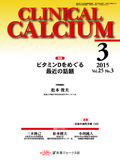Japanese
English
- 有料閲覧
- Abstract 文献概要
- 1ページ目 Look Inside
- 参考文献 Reference
ビタミンDの主たる作用は,核内ビタミンD受容体を介した標的遺伝子群の発現制御と考えられている。ビタミンD依存的な転写制御の分子機構については,染色体環境の調節が極めて重要であることが明らかにされつつある。本稿では,エピゲノム制御の本態でもある染色体構造調節の分子機構を,ヒストンタンパク修飾による染色体構造調節やヌクレオソーム配列の再整備について,それらヒストンタンパク修飾酵素や,染色体構造調節関連因子による転写とエピゲノム共制御を中心に概説する。
Most of vitamin D actions mediate expression of target genes regulated by nuclear vitamin D receptor(VDR).Regulation of chromatin environment has emerged to underlie gene regulation by liganded VDR. Active state of chromatin is defined by specific combination of post-translational modification of histone proteins, and chromatin remodelers as nuclear complexes conduct dynamic shift of chromatin sate. Among histone modifications, methylations of specific lysine residues located in the N-terminal tails of histone H3 are known to play pivotal roles in directing chromatin state, and the methylated lysine 4 and 9 in the histone H3(H3K4me and H3K9me)are widely used as indicators of chromatin state. The histone modifying enzymes and chromatin remodelers are thus regulators for chromatin environment, and overtly co-regulate transcriptional regulations of a particular set of target genes by nuclear receptors including VDR. In this review, the molecular mechanism of regulated chromatin configuration is described by illustrating modifications of histone proteins and rearrangements of nucleosome array and their regulators.



